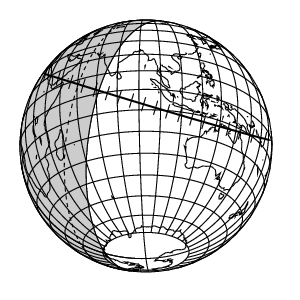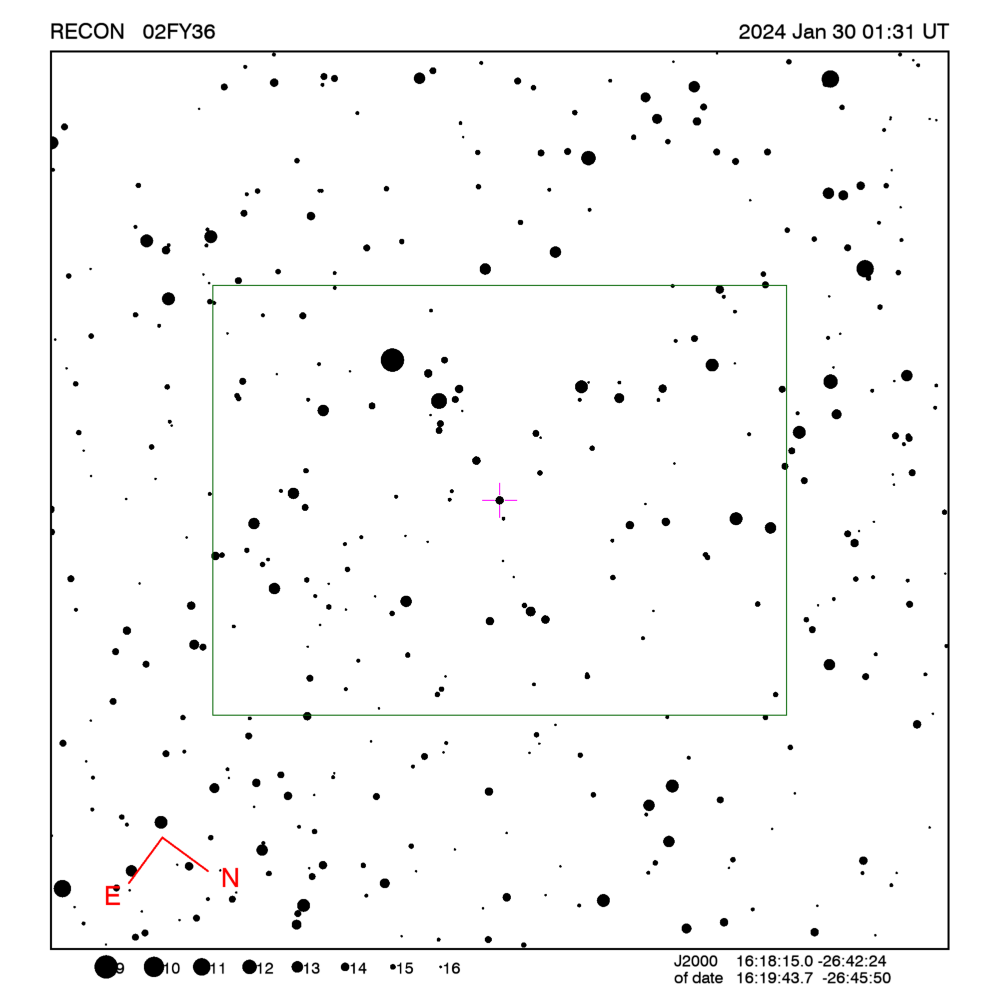RECON: TNO occultation with 02FY36
Event between 02FY36 and star GA0620:08443175
with event index number of 2785899
Geocentric closest approach at 2024/01/30 01:30:05 UTC
J2000 position of star is 16:18:15.0 -26:42:24
Equinox of date position of star is 16:19:38.7 -26:45:39
Stellar brightness G=14.8,
use SENSEUP=128 with the MallinCam and and exposure
time of 2 seconds with the QHY174 camera.
Star is 71 degrees from the moon.
Moon is 84% illuminated.
TNO apparent brightness V=22.4
 TNO is 22.7 AU from the Sun
and 23.2 AU from the Earth.
TNO is 22.7 AU from the Sun
and 23.2 AU from the Earth.
The TNO is moving 21.6
km/sec on the sky relative to the star, or,
4.6 arcsec/hr.
The 1-sigma error in the time of the event is 154 seconds.
The 1-sigma cross-track error in the shadow position is
1264 km.
The TNO has an absolute magnitude Hv=8.6
Diameter=118.6 km assuming a 5% albedo -- 5.4 sec chord
Diameter=48.4 km assuming a 30% albedo -- 2.2 sec chord
Dynamical classification is CENTAURR
Star training set for 02FY36, (2024/01/30 01:31UT)
Object RA Dec mag sep mel
Antares 16:30:53.3 -26:29:00 0.9 2.51 73
23Tau Sco 16:37:23.1 -28:15:50 2.8 4.19 75
13 Sco 16:13:47.5 -27:59:13 4.7 1.80 70
PPM 265313 16:16:48.0 -27:16:12 7.9 0.83 70
PPM 265402 16:21:06.7 -26:55:55 9.2 0.35 71
PPM 265393 16:20:33.2 -27:01:06 10.3 0.31 71
02FY36 16:19:43.7 -26:45:50 14.8 71
Positions are for equinox of date

Azimuth is measured in degrees eastward from north.
North is at an azimuth of 0, due East is at an azimuth
of 90 degrees, due South is 180, and due West is 270.
Do not use the listing below for the RECON CPC 1100 telescopes.
This is provided for other non-team facilities.
Star training set for 02FY36, (2024/01/30 01:31UT)
Object RA Dec mag sep mel
Antares 16:29:24.4 -26:25:56 0.9 2.51 73
23Tau Sco 16:35:52.9 -28:12:58 2.8 4.19 75
13 Sco 16:12:18.2 -27:55:36 4.7 1.80 70
PPM 265313 16:15:19.0 -27:12:40 7.9 0.83 70
PPM 265402 16:19:37.9 -26:52:31 9.2 0.35 71
PPM 265393 16:19:04.3 -26:57:42 10.3 0.31 71
02FY36 16:18:15.0 -26:42:24 14.8 71
Positions are for J2000
Event circumstances last updated at 2022/09/27 03:29:13 UT
Marc W. Buie,
Southwest Research Institute
RECON
 TNO is 22.7 AU from the Sun
and 23.2 AU from the Earth.
TNO is 22.7 AU from the Sun
and 23.2 AU from the Earth.
